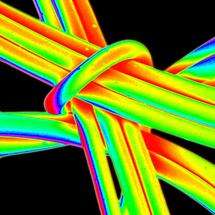Researchers find the 'breaking point' of proteins

Scientists from Oxford University have discovered the watery secrets of what makes proteins unstable.
Their fundamental research into the ‘critical condition’ at which the biological function of proteins is destroyed could have a profound impact on many areas of science – including biology, materials science and medicine: In particular it could give fresh insights into diseases caused by proteins misfolding and how to mimic the properties of tissues such as cartilage and collagen.
The discovery comes from quantum mechanics simulations developed by Dr David Porter and Professor Fritz Vollrath of Oxford’s Department of Zoology. ‘The interaction of water with proteins is central to all biology, and the point at which water-protein interactions become unstable is arguably nature’s most important ‘critical condition’,’ said Dr David Porter. ‘We can use these simulations to examine the physics and chemistry of hydrogen bonding between water and amide groups in a specific protein. The predictions from our models can then be translated into real biological stress conditions – of temperature, mechanical load and chemistry – that will cause this protein to become unstable and stop functioning.’
The new research also sheds light on how the amount of water in a protein tissue affects its relative ‘softness’ and overall structural properties. Proteins with relatively little water will be stiff but tough – like a hard plastic – whereas a larger fraction of water (above 30 per cent) makes tissues such as elastin highly flexible and strong.
Dr Porter and Professor Vollrath originally created the simulations to try to understand how spiders ‘tease’ a normally stable protein solution into a solid silk thread using a combination of stress mechanisms; temperature, mechanical load and chemistry. ‘It soon became clear that our silk model could be applied to many other protein stability problems,’ said Professor Fritz Vollrath. ‘A key innovation is that our models can map how instability develops over a time period of anything from a few seconds to a hundred years. Understanding the role of water in biological materials will be very important as we try to create new materials with predictable properties.’
The innovative use of new ways to extract critical conditions from their quantum simulations could have many other important applications in materials science: They could be used to predict the conditions under which materials will melt or move between an ordered and a less ordered state. Professor Vollrath said: ‘Clearly we can learn much more from spider silk than how to make a tough material.’
Source: Oxford University


















